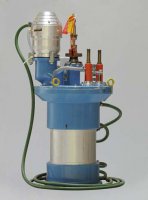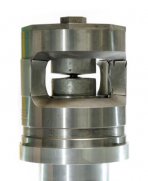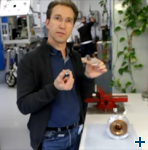The SINE2020 Sample Environment WP:
Interview with the coordinator Eddy Lelièvre-Berna
In an interview Eddy Lelièvre-Berna tells about the SINE2020 collaboration activity on Sample Environment, which he coordinates.
30/08/2016
Contact: Eddy Lelièvre-Berna
Partners: ILL, ESS, STFC, PSI, TUM, CEA, HZB, HZG, CSIC, NPI
Eddy Lelièvre-Berna is the Head of Services for Advanced Neutron Environment at the Institut Laue-Langevin (ILL) in France. He told Inês Crespo about the aims of the SINE2020 Activity on Sample Environment (SE) which he coordinates. This activity, which will run for four years, aims to improve the environment surrounding samples both on neutron and muon experiments, thus improving data statistics and opening new fields of science. Thanks to close collaboration fostered by SINE2020, each member’s developments will be useful for the other facilities.
1. Standards for better instrument-SE communication
The first task is to develop standards to facilitate the communication between the instrument control work station and the sample environment equipment. Currently, to be able to remotely control temperature, pressure or humidity during an experiment, scientists need to write pieces of code that are specific to the equipment available at each facility, as each facility does it differently. It is time to tackle this issue. We will start by defining two standards: what we communicate (metadata) and how we communicate it (protocol). The aim is that the European Spallation Source (ESS) will use the standards we develop within SINE2020, and hopefully other facilities will be able to adopt it.

1600°C ILL blue furnace by A.S. Scientific. © Ecliptique, L. Thion.
2. Making neutron SE more efficient
The second task is to work towards an efficient sample environment for neutron research. One of the approaches is to improve the signal-to-background ratio in the detectors, i.e. to reduce as much as possible the background produced by the environment around the sample. For instance, by changing the diameter of a cryostat, one can reach an optimal diameter that reduces the background noise. We will first develop software to simulate the equipment and thus have an estimate of the background it produces. Once we reach optimal dimensions, we will modify our equipment, solve issues raised by new geometries and expect to improve the performance by as much as a factor of five in the signal-to-background ratio.
The second approach is to improve experiments by providing tools to facilitate them and reduce beam-time losses. For instance, when we insert a sample in the dilution fridge, cool it down, and connect the beam, we typically need half a day to reach the temperature we need. If we realise that we are misaligned by 3°C we have to warm-up the system, move the sample, re-align it… This process is very time consuming. So our aim is to have a remotely controlled goniometer(*) inside the dilution fridge. Another way to reduce beam-time losses is to speed up the process of cooling down samples in furnaces, as nowadays the samples take 2-3 hours to cool down before we are able to open the furnace. All these issues make experiments longer, so we are working on making the process more efficient.
(*) [A goniometer is a tool that allows tilting the sample.]
3. Next generation pressure cells for neutron and muon research
The third task is to build a new generation of pressure cells from new materials and designed from novel geometries to boost the capabilities of neutron scattering and muon spectroscopy. There are several steps to take to achieve this. The first step is to improve the piston cell for muon instruments because the current cell is difficult to use and there are a number of issues that need to be improved. The second step is to design a high-pressure cell that we could use both in neutron and muon instruments.

25 GPa Paris-Edinburgh cell by MG63.© Ecliptique, L. Thion.
Another idea is to improve the vertical angular access to samples compressed in Paris-Edinburgh cells, as currently it is very difficult to reach the sample. Furthermore we would like to replace the anvils and the pressure-transmitting media by materials transparent to neutrons. The anvils currently used are absorbent to neutrons because it was created so that scientists could look at the sample alone. This however stops neutrons from reaching the sample. The pressure-transmitting media scatter neutrons and produce background that we would like to reduce using e.g. gases.
We will also look at ways to develop new clamp cells. Clamp cells are generally quite small and fit in high-field magnets. They are locked (or clamped) under pressure at the lab and transported to the beam for measurements. Our plan is to investigate whether we can have several layers of different materials. By using the technique of multi-layer geometry we can certainly improve the cell’s transparency and decrease the diffuse scattering of the cell. So we will work on a number of ideas to make better clamp cells.
We shall also develop a 700 bar hydrogen container. Neutrons are ideally suited for investigating hydrogen storage directly and our aim is to provide equipment matching industry requests.
4. Complementary in-situ measurements for neutron and muon experiments
In task 4 there are two different projects which have common ground as both aim to make complementary measurements on the beam, one for neutrons and another one for muons. For muon research the aim is to build a cavity with a RF field that enables to explore mechanisms in chemistry and chemical physics. For neutron research the aim is to build a compact low-field NMR system sitting on a neutron beam that will allow the simultaneous measurement of diffusion coefficients not accessible with neutrons.





